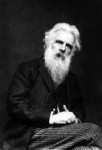
Eadweard Muybridge
English, 1830-1904 (active USA)
Raccoon Turning Around, 1887
collotype
8 x 15 in.
SBMA, Museum Purchase
2013.21.3

Eadweard Muybridge - undated photo
"‘Science can never furnish a substitute for the artistic sense. But there is no reason why the artist should not avail himself of all that science can teach him." - Eadweard Muybridge
COMMENTS
English photographer, active in the USA. He was the first to analyse motion successfully by using a sequence of photographs and resynthesizing them to produce moving pictures on a screen. His work has been described as the inspiration behind the invention of the motion picture.
Born Edward James Muggeridge, he emigrated around 1852 to the USA, where he first worked for a firm of publishers and later became a book dealer. After a stagecoach accident in Texas in 1860, he returned to England, where he took up photography. By 1867 he was back in California, describing himself as ‘Eadweard Muybridge, artist–photographer’. During the next five years he took over 2000 photographs, selling many of them under the pseudonym Helios. Muybridge made his name as a photographer with a successful series of views, Scenery of the Yosemite Valley, published in 1868. In 1872 he was commissioned by a former governor of California, leland Stanford, to photograph his horse, Occident, trotting at speed. The aim was to test Stanford’s theory that at some stage in its trot the horse would have all four feet off the ground. Muybridge’s first photographs were inconclusive, but further attempts in 1873 appeared to prove the point, at least to Stanford’s satisfaction. Work was interrupted by a dramatic crisis when Muybridge, tried for killing his wife’s lover and acquitted, found it prudent to make a photographic expedition to Central America.
In 1877 Muybridge returned to the problem of the trotting horse and began the work which was to make him famous. He designed an improved shutter to work at the astonishing speed of one-thousandth of a second and used all his experience to sensitize his plates for the shortest possible exposure. When the resulting retouched picture of Occident in arrested motion was published in July 1877, it was so different from the traditional artist’s impression that it created a minor sensation . The next year Muybridge embarked on an even more ambitious series of experiments. In order to secure a sequence of photographs of horses in various stages of trotting, he set up a battery of 12 cameras fitted with electromagnetic shutters. These were activated by strings stretched across the track. Muybridge later repeated his experiments using 24 cameras. The subsequent photographs were widely reproduced in publications throughout America and Europe. The publicity led Muybridge to design a projecting device based on an optical toy by which drawings derived from his photographs could be projected on to a screen as moving pictures. During the early 1880s he toured Europe with this instrument, termed the zoopraxiscope, and a large collection of lantern slides. With the latter he was able to demonstrate that artists throughout the ages had depicted the horse in attitudes that were completely false.
On his return to America, Muybridge quarrelled with Stanford, but in 1884 he was able to begin work at the University of Pennsylvania using elaborate banks of cameras to analyse animal and human motion by means of photographs. He took over 100,000 photographs, 20,000 of which were reproduced in his major publication, Animal Locomotion (London, 1887; for example). This 11-volume work had a tremendous impact, not least on artists, who were forced to reassess completely the manner in which they depicted animal movement.
Muybridge finally returned to England in 1900. He bequeathed numerous relics of his work to Kingston-on-Thames Public Library, a great proportion of which is on loan to the Science Museum, London. Other major repositories of Muybridge’s work include the Bancroft Library at the University of California, Berkeley, the Stanford University Library and the Stanford University Art Gallery and Museum.
- J. P. Ward, "Eadweard Muybridge", Grove Art Online, Oxford University Press, 2009
http://www.moma.org/collection/artist.php?artist_id=4192
